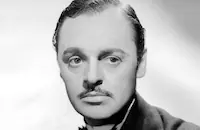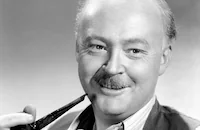Getting Gertie's Garter

Brief Synopsis
Cast & Crew
Allan Dwan
Dennis O'keefe
Marie Mcdonald
Barry Sullivan
Binnie Barnes
J. Carrol Naish
Film Details
Technical Specs

Synopsis
Dr. Kenneth B. Ford, a researcher at Boston Mass Hospital, is working on a new anesthetic when he receives news that he has been elected to the prestigious Society of Scientific Research. Ken is thrilled about the honor, but his delight sours when Winters, an investigator from the district attorney's office, arrives at his laboratory and asks to talk to him about a case involving a larcenous jeweler. Winters questions Ken about an expensive purchase he made two years earlier, and although Ken pretends not to remember anything about it, he is obviously concerned. Winters gives Ken a subpoena ordering him to testify about the matter the next morning, and warns him of dire consequences if he does not comply. As soon as Winters leaves, Ken calls Gertie Kettering, his former sweetheart and a glamorous artist, and drills her about the purchase in question, an elaborate jeweled garter engraved with the words, "To Gertie from Ken, with all my love." The conservative Ken, who fears that the bauble will arouse the ire of his wife Patty and cause a scandal, demands that Gertie return it. Gertie states that she has sent the garter to Ipswich, where she is to be married to Ted Dalton, Ken's best friend and lawyer, the next day. Dispirited, Ken returns to the laboratory and finds Patty waiting to watch the experiment that he is to conduct with the new anesthetic. During the experiment, Ken mutters about the garter and the subpoena, and the jealous Patty, who has learned about Ken's proposed clandestine visit to Gertie, follows him when he goes to Ipswich that evening. When Ken arrives at the home of Ted's sister Barbara and her husband Billy, he begs Gertie to return the garter so that he can destroy it. Gertie overhears a conversation between Ken and Ted, however, and misunderstands Ted's remarks to mean that he disapproves of unmarried women who accept jewelry. Gertie then decides to keep the garter to prove her innocence in case Patty and Ted suspect her of wrongdoing. She orders Ken to reveal the truth, but Ken, who has developed a complex about keeping the garter's existence a secret, determines to get it away from her. Patty becomes increasingly jealous as she sees Ken and Gertie heatedly confering, and while trying to eavesdrop on them, falls into a rainbarrel outside the house. Soaked, she hides in the barn, where Billy finds her. When Billy enlists Ted's help in obtaining dry clothes for Patty, he arouses the suspicions of Barbara, who believes that Gertie and Ken are conducting an affair in the barn. Meanwhile, the garter has fallen into the hands of Charles the butler, who intends to use it to blackmail Ken. Gertie persuades Charles' wife Anna, the maid, to retrieve the garter and place it in the barn, which leads to more complications. Eventually, the garter winds up back in Charles' hands, and Ted catches Gertie and Ken in a compromising position. Ken then finds Patty wearing only a horse blanket, hiding under Ted's bed, and Barbara is shocked to see Billy covered with hay from the barn. Ken and Gertie attempt to explain about the garter and the subpoena, but because they cannot produce it, no one believes them, and everyone declares their respective relationships to be over. Just then, Charles approaches Ken and Gertie, hoping to incite them into a bidding war over the garter. After Billy claims the garter, Ken and Gertie, their story proven, reconcile with their loved ones, while Billy and Barbara, and Charles and Anna also embrace.

Director

Allan Dwan
Cast

Dennis O'keefe

Marie Mcdonald

Barry Sullivan

Binnie Barnes

J. Carrol Naish

Sheila Ryan

Jerome Cowan
Vera Marshe

Donald T. Beddoe
Frank Fenton
Richard Le Grand
Crew
Howard A. Anderson
Joe Bigelow
John Carter
Harry Judson Curtis
Karen Dewolf
Allan Dwan
Louis Forbes
Walter Hannemann
Joseph I. Kane
Ted Larsen
Charles Lawton Jr.
Frank Melford
Sam Nelson
Odette
Edward Small
Joseph Sternad
Grant Whytock
Grant Whytock
William H. Wilmarth
Truman K. Wood
Henry Zane

Videos
Movie Clip


Film Details
Technical Specs

Articles
Getting Gertie's Garter
To modern audiences, the premise is innocent enough - a newly married man (Dennis O'Keefe) has to appear in court as a witness in an embezzlement case against the clerk who sold him a jeweled garter, and then ran off with the money. The garter in question was a present for O'Keefe's then-girlfriend, Gertie (Marie "The Body" McDonald), an exotic dancer who is about to be married to another man (Barry Sullivan). O'Keefe needs to retrieve the garter from McDonald before his new wife (Sheila Ryan) finds out. Also in the cast were Binnie Barnes and J. Carrol Naish.
Producer Edward Small and legendary director Allan Dwan had been successful with another film starring Dennis O'Keefe and Binnie Barnes, based on a Wilson Collison play, Up in Mabel's Room (1944). Obviously fond of Collison's work, Edward Small wanted to make Getting Gertie's Garter as early as May 1942. He petitioned the idea to the censors, who thought the title was too risqué and refused to approve it, making it unlikely that Small would be able to clinch the film rights to the play. Small finally signed the deal on March 28, 1945, but the censors hadn't budged. According to Small, "[The censors] had the same idea [as with Up in Mabel's Room] that we were going to make the wrong kind of picture. When they learned that we intended making a picture acceptable in every way from the standpoint of the [Production] code, they were willing to register the title."
Production began (without a title) in the late spring of 1945, using a script that had seen nine writers, although only director Dwan, Karen DeWolf, and Joe Bigelow received final screen credit. Finally, on June 22nd, Will H. Hays, head of the censor board, wrote a personal letter approving the use of Getting Gertie's Garter as a title, but warned the producers "that extreme care will be exercised in the advertising and exploitation in connection with the title and the picture."
For such a "risqué" title, Getting Gertie's Garter was a rather tame film, and when it was released on November 30, 1945, the critical reaction was decidedly mixed. Notoriously cranky New York Times critic Bosley Crowther wrote that "Edward Small, to whom society owes nothing in the way of gratitude for his previous cinematic disinterments of Twin Beds [(1942)] and Up in Mabel's Room has again raided the cupboards in which old stage farces are filed away and has hauled down Getting Gertie's Garter, which he has given a dusting off." The film, wrote Crowther, was "no better (but may be worse) than you'd expect." The anonymous film critic for the Ottawa Citizen disagreed, calling Getting Gertie's Garter "a fast moving gay comedy which is guaranteed to keep you in stitches from beginning to end."
By Lorraine LoBianco
SOURCES:
http://www.tcm.com/tcmdb/title/76173/Getting-Gertie-s-Garter/
http://www.allmovie.com/movie/v92897
The Internet Movie Database
Lombardi, Frederic Allan Dwan and the Rise and Decline of the Hollywood Studios
"Reviews of Current Films", Ottawa Citizen 22 Feb 46
Roberts, Jerry The Great American Playwrights of the Screen: A Critical Guide to Film, TV, Video and DVD

Getting Gertie's Garter
Quotes
Trivia
Notes
Wilson Collison and Avery Hopwood's play was filmed two times prior to this production: a 1927 Metropolitan Pictures picture, titled Getting Gertie's Garter, directed by E. Mason Hopper and starring Marie Prevost and Charles Ray (see AFI Catalog of Feature Films, 1921-30; F2.2057); and A Night of the Garter, a 1933 British release, produced by Dominions Film Corp., directed by Jack Raymond and starring Sydney Howard and Winifred Shotter. Getting Gertie's Garter also closely resembles the 1944 United Artist release Up in Mabel's Room , which also starred Dennis O'Keefe.














